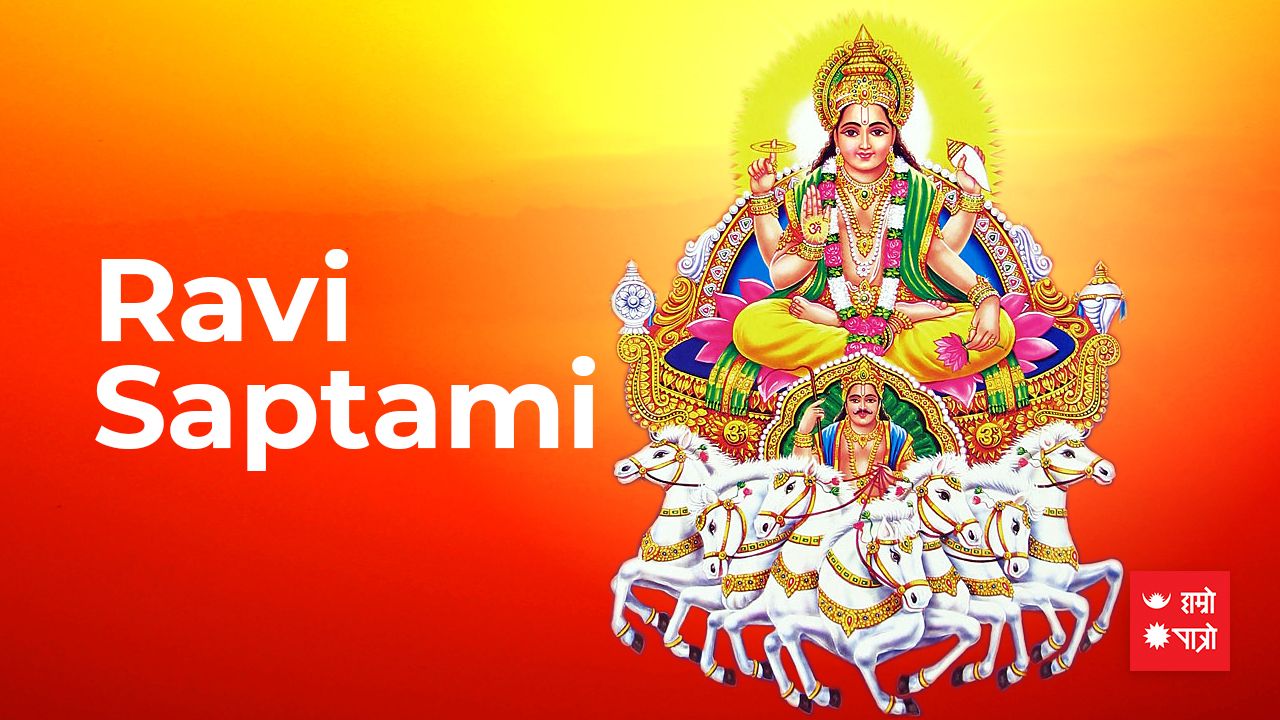
Do you know, if the Sunday falls on the Saptami tithi, this day is considered as Ravi Saptami, today is Sunday and the tithi is the seventh day or Saptami. On the day of such a coincidence, worship of Lord Surya Narayan, fasting, etc. is performed. Worshiping the Sun God, the revered deity of the Navagrahas and the gods, by enlightening the whole world with the radiance of His nature. Worshiping the inspiring Sun God on this day to attain the position, prestige, prosperity, child happiness, and the desired outcome. The Sun God is considered to be the Sattvic form of Brahma in the dawn, the Sun God who gives Tamo guna at noon is considered to be the form of Devadi Dev Mahadev during the afternoon, and the Sun which exists in the majestic form in the evening art is considered to be the Vishnu form. Sun, in itself, is a mixture of several forms and features of god and godly power, a reference point of this creation and the lord of all planets.
Chant:
Surya is depicted with chakra, which is called Dharma Chakra and depicted as an epithet for major Sanatan gods, Brahma, Vishnu, and Maheshwar.
उदय ब्रह्मणोरुपं मध्यान्हेतु महेश्वर: ।
अस्तकाले स्वयं विष्णु त्रिमूर्तिश्च दिवाकर: ।।
In the process of worshiping and adoring Bhagavan Surya with twelve characteristics, Dhata, Aryama, Mitra, Varuna, Indra, Vivasvanta, Pukha, Parjanya, Anshavan, Bhaga, Tvashta, Vishnu, etc. 12 forms are worshiped.
The brightly shining Sun signifies the power of universal consciousness, Vedas declares the Surya to be the creator of this universe and more parallel universes. Darwin also brings the same logic in his theory of evolution, the unicellular creator evolves into a human being in this universe because of the favorable environment contributed by the Sun. Vedas states that wisdom, vision, self-determination, realization, power, light, and lives are the output of the sun and its rays. Ravi Saptami is a simple acknowledgment of Satan ritual towards the Sun, as Suryanarayanan.
Generally, fasting is done on Sunday to make the sun happy and bring good results. There is a scriptural statement that the fast of Sunday should start from the auspicious coincidence of Ravisaptami or the first Sunday of the Shukla Paksha. On the occasion of such auspicious coincidence, Surya Narayan should be worshiped by wearing red attires. If it is possible to fast for twelve months that’s perfect, but those who can't make twelve months can fast for twelve Sundays. On the day of fasting, one can fast by worshiping Surya Narayan and requesting Argha. Argha means offering water to the Lord Surya with folded hands.
By doing such fasting etc., the knowledge and intellect will be as bright as the sun and according to astrology, if there is a solar defect and planetary pain in the birth horoscope of the person born, the worship done on such an auspicious day will reduce the planetary pain and get auspicious blessings of Suryanarayana.
Mantra of Surya Argha
एहि सूर्य सहस्रांशो तेजोराशे जगत्पते ।
अनुकम्पय मां भक्त्या गृहाणार्घं दिवाकरः ।।
ॐ भूर्ब्भुवः स्वः जगतसाक्षिणे श्रीसूर्यनारायणाय नामः ।।
Meaning, Lord Surya shall take care of wisdom, position, success, health, popularity, and all my desires.
Makar Snan Samapti
Divine five elements (Panchatatwa) in Sanatana philosophy
Sanatan ritual focuses on the scientific and divine five elements (Panchatatwa) of which our universe and body are made from. Pancha refers to five and tatwa means elements, according to the universal law of creation everything on this planet is composed of the basic five elements of "PanhaBhutas". PanchaBhutas are Akash (Space), Vayu (Air), Jal (Water), Agni (Fire), and Prithwi (Earth).
Now let me get into the relevance of panchatatwas in Makar snan which correlates with the holy month of Magh. Magh is considered as one of the auspicious months where our proximity with panchabhutas are higher. Scarify, austerity, and donations performed in this month have higher significance compared to all other months. Hereby I refer Santa Kabi Tulsidas where he writes about the month of Magh on the Balkanda of his Ramcharitra Manas.
‘माघ मकर गति रवि जब होई, तीरथपतिहि आव सब कोई।’
Magh or Makar is the month where the power of the sun slowly rises in this planet and with this also the series of pilgrimage and festivals come nearer.
If the whole year (12 months) was a day, Magh would be the morning as the power of the sun starts to increase from Magh. Magh snan is a divine ritual that commences from Poush Shukla Poornima and ends in Magh Poornima. Magh snan is one among several effective sanatan interventions which maximize the positive impact of panchabhutas in our life and avoid the inviolability of our living context.
गंगे यमुने चैव गोदावरि सरस्वती। कावेरी नर्मदे सिन्धोर्जलअस्मिन्सन्निधिं कुरु॥’
The above hymn is chanted before taking a dip into the water, the purity and positive flow of water are then translated into our body. Magh snan occurs for 30 days and huge pilgrimages can be seen in holy places like Shali Nadi, Bagdwar, Devghat, holy ponds of Mithila, and other places. Magh is also a month for world peace and prosperity, may all the rivers of this world flow with peace. The country of Mt Everest hereby makes a strong wish for peace, may the river Jordan flow with peace, May Nile, Huang Ho, Hormuz passage, Amazon, Yangtze, Niagara Falls, and all flows flow with peace.
Shanti Hi, Shanti Hi, Shanti Hi!
Suyog Dhakal
Liked by: